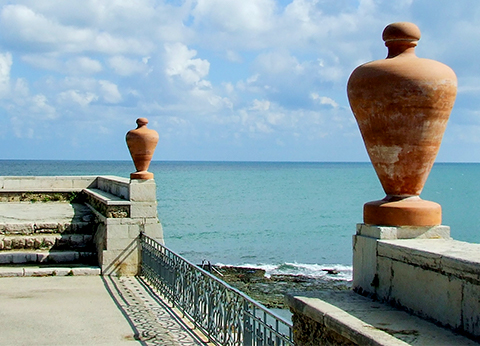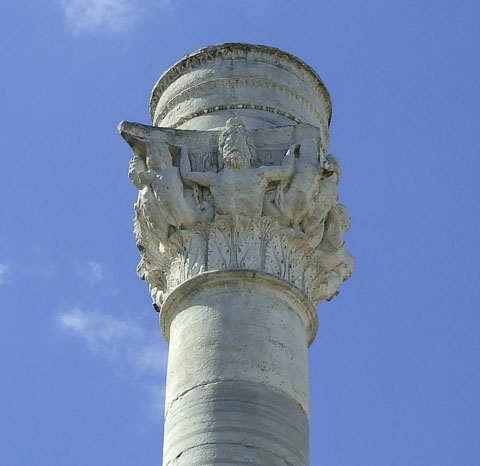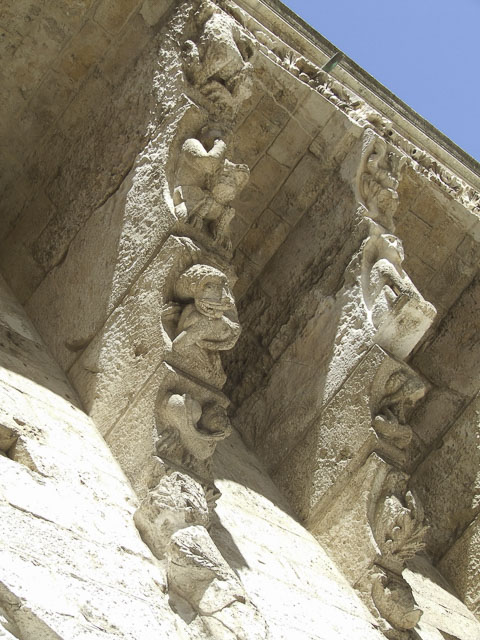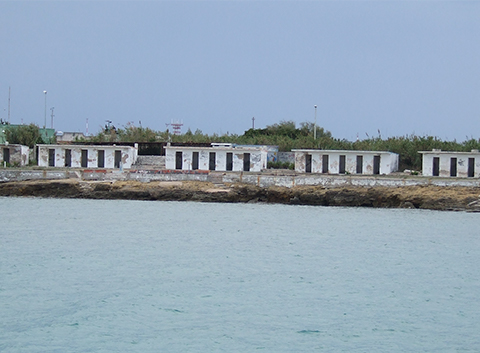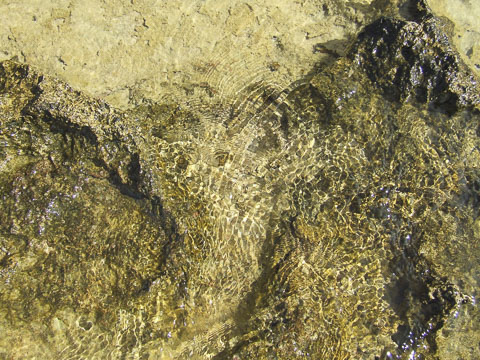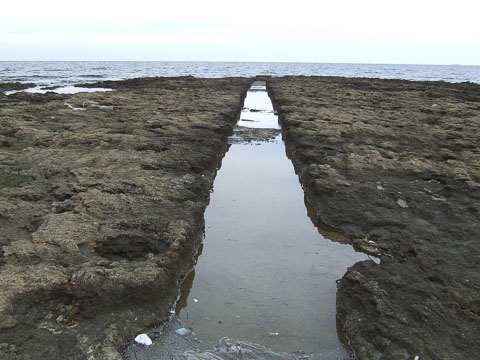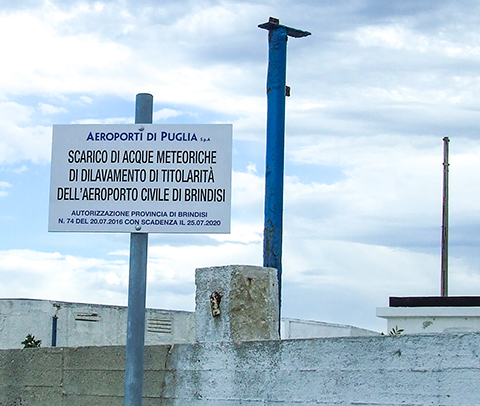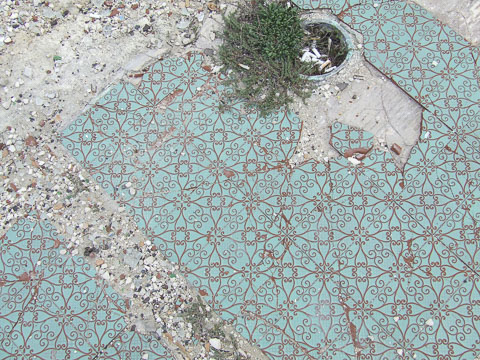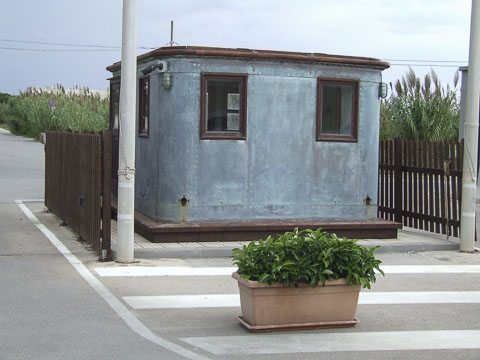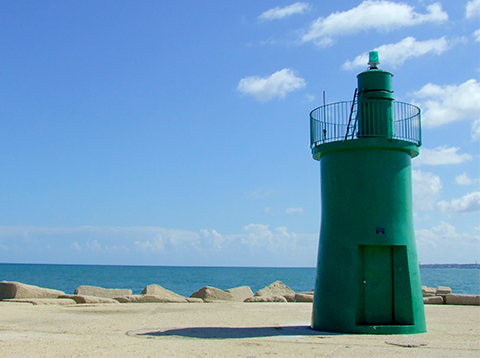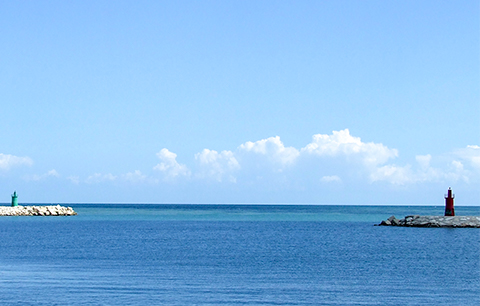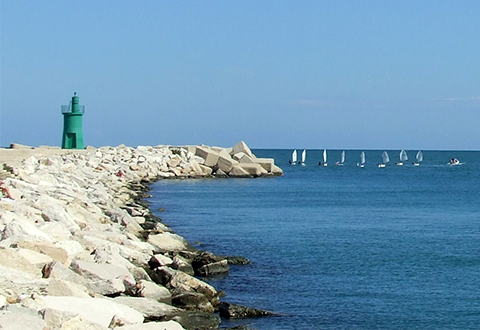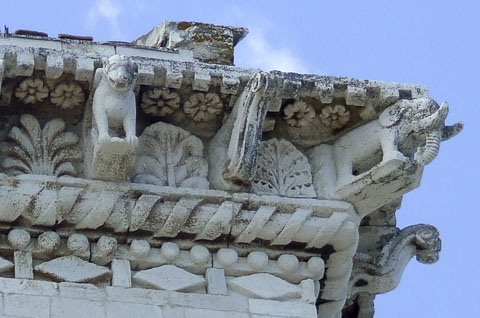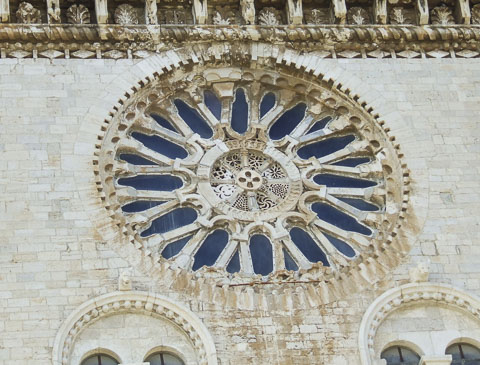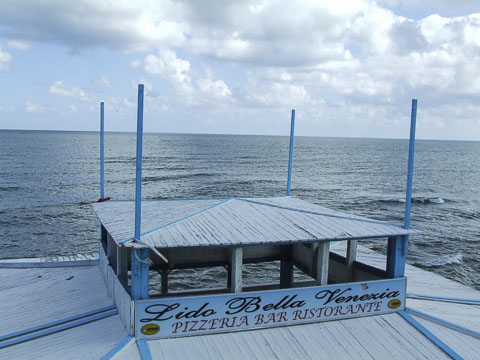x
Brindisi
Start out to the centre of a city chosen at random, let it be Brindisi. From the train station a promenade leads straight to the sea, lined with palm trees: their shadow striates the pavement in the noontime sun, horizontal window grids. The town is daydreamy, as if caught in an endless afternoon, all the shops about to close. The promenade saunters at leisure into a tree-lined square, then continues seaward: the circle that can be drawn in the middle of the square has two fountain crescents on its sides, water trickles on a squat wall’s horizontal yellow, red, green mosaic strips into a basin painted deep blue. The promenade leaves the early afternoon park behind, in it the few Africans sunken into themselves, whose aloneness is not alleviated, but rather thickened by their cellphone music. The music reaches out after the shadows of the passersby, always one step behind. From the windows, the clinking of cutlery.
The promenade has its palm trees and its procession: light processes on it all day long. Before reaching the sea, it slows down in a little park among four symmetrically planted olive trees. There are no two olive trees that look alike. In the middle a clamant white marble statue, the two twisted animals at the poet’s feet, a dog and a lamb, look as if carved from preposterously bleached, knotty olive-tree wood: here Virgil lay dying on his return from Greece.
The poet looks out on the sea, on the tongue of land closing in the sea behind the two harbours, and beyond them, to the wider outer sea. Because the town has two waterfronts: city between two waters, with a sea locked between two land strips. Levante and ponente harbor basins, the water-faces turned to the upward- and downward-going sun.
The lungomare is one sole theatre balcony gazing out at the sea: its consoles are the palm trees that by their hair fasten it to the sky, so it can’t drift out on the high waters.
Go up a flight of stairs to the one-and-a-half column marking the end of the Via Appia: one fell and broke into pieces, its capital a pedestal today, in Lecce, for a saint. The fragment of its trunk lies sideways on a tall base, broken not in splinters but along knotty sinews. Like a slice of some gigantic flayed animal, a tuna trunk laid out on a counter, in it the muscles’ inward-turned cramp, the inward-glowing gaze of the stone flesh. The divinities on the intact column’s capital are caught in the instant of their winged dash, just about to hurl themselves on the blue, on a liquid crystal airwave, their gazes their wings. Their flight throws the sky open and lengthens distances.
The column stands in the air, not on the ground: in the light, compacted into a slab it froze into the instant of stepping out of the blue and entering our space, to become flesh. The height is situated at the place where the seno di levante, the harbor basin turned to the upward-going sun, abuts the seno di ponente, the harbor lying towards the downward-going sun, close to the old town’s cape east where it presses its face on the water, like a statue on a prow. Across the water, the canal between the two harbours leading out into high water: a sea gorge. The columns look beyond the landmark willed by Mussolini, the monument of the seamen fallen at sea: the capital of the intact column is windblown hair, while across it the human figure on the oversize reddish-ochre wedge cutting into the water is a monumental trinket, indomitable carved cliché. At the foot of the stairs, a patient little archaeological collection: the volutes of its Attic, Italic vases glow like candelabra in their showcases; the goose, deer, drapery fold sketched in white on the lacquer-like blacks, dark browns and reds of Gnathian vases resist the pull of museum death. The flavor of ancient oil or wine impregnates their walls, as the August sun, a memory shred, impregnates the bleached, graying skin at winter’s end.
The yellow triangle of the square in front of the cathedral is there to fence in the sky. Its lines of sculpted bishops’ staves and downward-turned faces are choruses answering one another from the galleries. Shadows are razor-sharp in the blazing sun. The animal-faced consoles, thick like a comb, supporting the Gothic balcony of the palace that obliquely closes the square on the right, are fulgent apparitions. The façade clings to the balcony, lest it rise with slow wingbeats above the roof of the palace opposite. A dancer’s naked back drifts across the square, bearing a vertical message inscribed along the spine, its beauty a see-through lightning.
The orange circolare connecting the peripheral districts meanders on the patched-up asphalt among concrete fences, roof-terraced blocks of flats, to the sea. Now and again an unwitnessed transfiguration on the empty streets: magenta masses of bougainvillea spread out on a wall, the gigantic foliage of a pine tree which, as light traverses it in the wind, looks deciduous. In the frame of burnt-out lawn and unbroken façades only the colours of awnings gesticulate wildly. With their short shadows, the empty bus stops are banal sundials, the whitening afternoon oozes away around them. Now the bus is driving straight ahead between the barbed-wired fences of the military and civil airport, leaving the inhabited areas behind. The Indian figs pay no heed to the barbed wire, they are both inside and outside, nonchalantly showing off their red and yellow figs. Where the bus drops me off (you go ahead, there’s the sea), the road forks: in the bifurcation the hideousness of an unfinished dark gray concrete building is trying to withstand the assault of green and blue. In front, a short concrete fence: its sediment of graffiti, rain and sun looks like a Cy Twombly.
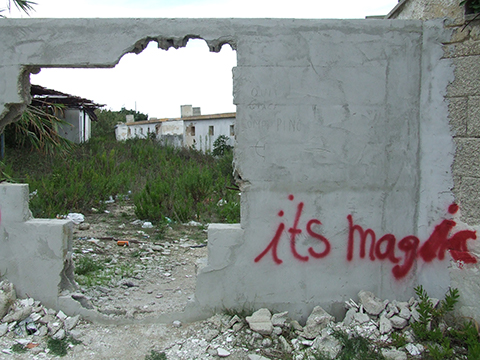
On one side of a gaping hole in the fence, a sign prohibits entry and warns of crumbling structures; on the other side, a graffiti points at the hole: IT’S MAGIC. Beyond the wall a row of aligned squat bungalows, their whitewash long washed off: a brittle youth summer camp above the waterfront. Inside, in the forbidden zone, a few teenage boys are dressing, their radio turned to the maximum. The shores of the little gulf are impatiently lapping up the rolling waves with flat rocky tongues. To the right, the road continues in a long pier; beyond the pier lies the industrial port with its cranes and tows. To the left, several fishermen, unstirring anthropoid cranes; on this side in a hollow, two women are sunbathing in deck chairs they somehow balanced on the rocks. A graffiti points the way to the pier: PUNTA RISO, Cape Ridicule. Tucked in the underarm of the industrial port, this no-man’s-land is a secret passage to the sea, a postindustrial outing destination, private adventure park, ridiculously beautiful garbage dumping site fitted out with billboards FOR SALE/TO LET. I’ve always imagined the Algerian seaside in Camus’ L’Étranger like this, stripped of picturesque adornments, a compact horizon within concrete lines and unrestrained stone growth, where the deeper and the higher blue touch.
The shore pitted to reach the sea’s horizontal line has nothing to do with those inexhaustibly photogenic cliffs modulating from deepest black to bone white, on which the coast towns are built. Here the stones are dark brown and dull red, with a reddish-yellow silt, as if springs high in iron were welling up among them. Looked at from above, they seem a broad, petrified strip of mud or argile that has been trampled, kneaded into these forms by invisible cloven-hoofed, web-footed, elephant-legged herds: edges and hollows everywhere, a plain of saw dents, pits, precipices, minute ravines squeezed among sandpaper pumice, against which the whipped-up Veronese-green water, blue only in the distance, lashes mercilessly. Deuterium. When a wave tumbles down and the tidal backlash sucks water out from among the rocks, for a moment a check pattern trembles on the dimpled water surface above the well-like hole: tugging in two directions, the flow tightens perpendicular water-threads woven above and beneath one another, the water fabric cambers upward like drum skin, before hollowing in again, to be broken into chips by the next wave. At the juncture between the water-threads tiny points of light vacillate, projected on the rocks: their spectral reflection still drifts on the rough matter, barely touching it, when the texture below is torn up by a new wave. Time captured in the trap of light.
When the sky is clouded over, the indigo blue of the distant waters is transposed into indigo green, and the golden reflections are supplanted by dimmed mercury light. The direction of the clouds cannot be guessed: they thicken above the sea, rise like dough, as if they were spreading out into several directions at once. After a while, metallic raindrops start falling from their blackish mantle. Between the heavily rolling lower and the rarefied upper waters a few oblique light beams, taut tightropes, measure distance like a jet airplane’s condensation trail, or a gull’s flight. The rocks on the shore retain all waste. On the bottom of a pit that fills up with seawater through invisible cracks, three springs from the deck chairs of yesteryear: they lie in geometric order, their rust colour delicately tuned to the rock, growing a spectral reddish-silver halo on the water surface, rich and strange. A few steps away, iridescent black rubber or plastic stains sea-changed into mineral sediment lead, like a path strewn with lentils, to another hole, tiny marginal sea, on which a white stain hovers: osso di seppia, the cuttlebone of a Sepia. The find asks for edgy Montale words. What ebb has shipwrecked the bone blade lighter than water? Like a paper cutting knife, to cut up the thickly inscribed pages of the waves folding upon one another.
A short-headed fisherman with a stout Guttuso frame is meticulously tenderising the day’s catch on the Polignano rocks: with one brutally proficient movement he sticks two fingers under the squid’s mantle, tears out the ink sac and something I presume to be the viscera. He gathers the ink sacs into a plastic bag and throws the other entrails, of the size of a fingertip, back into the sea, among the bathers. The thus-eviscerated creature he first smashes against the rocks with sparing movements, then methodically hammers and mangles into the rockface with a flat wooden bat, until the elastic arms are reduced to an amorphous jelly. Torn out into the empty air that burns its skinless limbs like acid, the creature bleeds a foamy, mucous liquid that looks as if secreted by a flock of snails. Its torment is perhaps only registered by the arms of its fellow creatures touching it along the linear network of pain. The smaller squids and octopuses do not get the bat: them the fisherman kneads, punches, rolls with his palm on the rough stone like dough, or clothes at the creek. Now and again he rinses them in the sea: I imagine the mollusks being hauled back into their own element, away from the scorching and suffocation, only in order to regain sensitivity for the first blow. The octopus is caught not with a net or spear but with the bare hands, the fisherman says, you need to have a good eye: il polipo è il migliore mimetizzatore. When it spots you it freezes, because it fears humans: this is the moment to grab it.
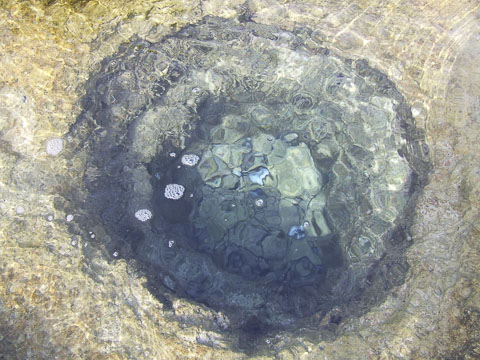
Several times I swim past a woman who is scanning the waters along the coastal cliffs, with a knife fastened to her wrist and a net in her other hand: a marine shopping bag. Out of the water, she cuts up the sea urchins gathered in the net, spoons out their flesh into a plastic bowl. Then aligns the empty, upward-turned shells on the stone, walnut or lychee peels; death has hatched from their sticky inside. The breeze smears the pebbles with the smell. The foaming, viscous blood of the octopuses dries on the stone into a rainbow. My last morning on the lungomare: fishermen toil on the massive breakwater rocks, vanno a faticà. In front of each of them, a plastic basin; one has a baby’s bathtub: they rock them like a cradle, not even looking. The congested mollusks are knocked together in a swill-like liquid, death’s whisks in the baby-tub. Below them, the unbroken, deep blue distance from which they have been evicted into the asphyxiating air. The foam whipped by the creatures short of sea and the pungent smell is all we hear of their agony; above them, bitten-off, close-vowelled words, with an intonation swinging to the rhythm of the rocking, narrate about sea weather.
At the entrance to the camp a sign warns of infiltration of acque meteoriche from the airport. Meteoric precipitation on the lunar landscape. Obviously the dark red stria cutting deep cracks into the rocks like tiny canyons are heavy metals that ended up here from a different planet. The rain dripping from the indigo clouds is in fact falling-star dust raining from outer space in drops the colour of mercury, pulled by the gravitational force of the tossing blackish-green water.
Going toward the pier, the riotousness of the stones is flattened out, like the waves running up on sand banks: it is drowned in the sand which has assimilated the glass chips and bottle corks. In the splinter-sand, a broken mosaic, the floor of an extravagant outdoor bathroom in the deserted camp: the archaeological find of a 1970s summer, it glows, turquoise and sky blue, from under the debris, determined not to gray for the fall. In its waters the fish and sea stars of the late antique mosaic, uncovered under the cathedral’s floor, could swim.
Summer’s layers can still be detected in the light storming the pine tree’s crown, like on the skin of the chic middle-aged ladies walking the Corso, whose tan is several hues darker than their honey-blond hair. Here the landscape doesn’t go bald and stiff for the winter, but rather, folds its wings like a bird. Es ist Zeit. Der Sommer war sehr groß. You can see from a distance that the bar at the foot of the pier is closed: the tropical colours of its spaghetti curtain get drenched in the evening. The Berlin-blue sentrybox squatting in the parking lot in front of the bar watches over the cold dust with its shortsighted windows. In the pavement, in an unfilled square where nobody has bothered to plant a shrub, a heap of peach juice boxes lie, sucked clean, their straws breathing a fruity bouquet: summer’s used-up condoms. In the evening, outdoing the racket of parakeets on the palm trees, a flight of swallows dementedly swarm around an exotic cypress. The crown preserves light for a while yet, moving ever upward, but the wind is let loose on the square.
x
x
Trani
From the protuberance of land into the sea, two long piers broken in angles set out like strong swimmers, then become disheartened: the sea renders all distances meaningless. At the end point where the piers turn back, two lighthouses stand like stout inverted exclamation marks; the sentences they introduce run beyond the horizon. Practical considerations aside, everything here serves the view: on the anthropodal piers’ end-points facing each other but tactfully looking away, the stocky lighthouses perform a rare stunt all day long. Almost jumping forward with their complementary green and red, like a Venetian painting’s red or white brushstrokes applied with calculated casualness, they push the sea into the background but, at the same time, their iridescent axis brings all the aqueous hues of blue, violet, mother-of-pearl, green to boiling point and show that the real drama is the one that takes place in the background. Figure and ground are thus continually oscillating, the shadow of a passing translucent cloud is enough to dull the green or red tower and push it back to ground.
As sunrays swim into the open from behind a cloud, lighting up the red and green lighthouses echoing one another on the two piers’ ends, first the one, then the other, the water is striped with turquoise-green, Berlin blue; closer up, Veronese green and, at the farthest point, navy blue. A stone bench made of a single block in front of a slender metal railing, nothing to detain the gaze. The Trani stone breathes, decomposes white into colours like Rome’s travertino, and captures every light. It is filled up with light and starts glowing: light-active stone, it radiates like radioactive metals. Between two layers splitting like slate, the cement of petrified shells: time’s congested ebb and flow.
Il mare non è il massimo a Trani, they warn me. As if it were not the same sea, of the same taste, burningly salt-bitter; as if it didn’t leave the same salt dust on the skin. As if our lego cities, toy trains could interest it in the least. Yet obviously the sea is not the same: the waters mouthing the coast cliffs of the undulating near-horizontal karst landscape are different from the sea that touches the crouching pebble shores further south, and whose backward-tossed waves sweep in the pebbles from the shore with a loud thudding and cracking. The amorphous waters dissolve different colours from the various stones and soils, as the maturing wine dissolves different flavours from the barrels made of wood of differing ages and qualities.
Those who know it well go to the sea in boats and yachts, not like the landlocked. The seagoers have their own well-trodden (well-glided should be the word) paths, waterways, bustling main thoroughfares and quiet side alleys; the sea surface is just as variegated for these flâneurs as the streets with their porches and shop windows. A few kilometers to the north, in capital letters on the Barletta sports yacht harbour’s blue corrugated iron barracks: CHI AMA IL MARE SARÀ SEMPRE LIBERO. At the landward bend of the asphalt path and running track that goes around the barracks, beyond the railings of the waterfront, a loaf of bread left out. Bread cast to the sea. This is my body. Let me in.
The anthropodal pier divides the waters: outside, the wider sea is thudding; crashing against the massive breakwater rocks, it boils up in foam; for an instant the stones get a sheen of a mirror’s silvering when water runs off them. It is impossible to decide the colour of the waves, their green glass side looks engraved, black looms in the hollows. There are many first-rate landscape painters on whose canvases the air is in movement, trembles, vibrates, but the sea has no truly good painter. Those who paint it mostly paint the reflections on the sky, on the landscape, in the air, of its tumultuous change of consistency. The great Dutch sea-painters paint ships first and foremost: convoluted knots and prow ornaments, forests of masts and sails to disentangle. Their sea is an embossed tapestry background. On the protected side the taut water surface mixed from turquoise and jasper is in still movement, it is no mere defoamed mini-sea smoothed out into a monumental pool. In the late afternoon a couple of porpoises venture into it. The breakwater rocks are patches of blotting paper in the glaring light, their porous surface retains all the reflections of the blue-white.
On the shore, the cathedral. They had to mark the place with a sign that is not dwarfed, not ridiculed by the distance measured in the horizon. Stone bread cast to the sea. Its cornice is something rich and strange, a gigantic frieze that could easily belong to an ancient temple’s architrave, were it not for the animal faces serving as its consoles. The sky rising from the cornice dilutes blue paint in sky water. It gathers in the white, the air around fills up with electric discharges. Immediately below on the corner, white glows. The interior is traversed by light as if by a magnetic wind, from the spokes of the rose window that starts spinning in the light like a pinwheel, to the apse that opens one sole, giant window to the east, onto the sea. One cannot tell which is the true façade, the one with the winged bronze door, or the one with the giant window looking out on the sea. The coast towns line up the Romanesque headquarters of light which turn their apse windows flanked by elephant-borne columns, their most precious ornament, to levante. It is not the relics and likenesses, but the light that is their holiest possession: the incessantly showering, radioactive light that solidifies into a block in the upward and forward propelling space, and which casts white shadows on the white walls.
Like most of Apulia’s cathedrals, this one, too, was restored “back” in style in the 1920s–30s, into homogeneous Romanesque, the crust of late Baroque (here, ottocento, antiquated even in its own time) stucco theatre wings, concave windows, boisterous statuary peeled off its rose windows, capitals, sculpted portals. Elsewhere, once the skins covering one another are removed, the spaces left behind are sterile, school textbook-like, and restoration turns out to have been retouching: against the intent to restitution, it is not their original, hidden life that buildings reveal, but the empty place of time, the imperishable and unbreathing would-be-alabaster china skin of fake eternity. But here everything is breathing: the wide-open-eyed animals of the capitals, the spoglio columns brought here from Roman buildings, the inscribed steles built into the walls, the stone folds. The church is like the archaic Greek statues: we know that they had inlaid pupils and were painted over, yet for us it is the whiteness of marble that drives time back into them. It is light that returns the erased gaze into Trani’s white, uncovered eyeball that now gleams in all its power: the wall is a scripted membrane through which time oozes in and out. The only ornament of the triumphal arch before the crossing is a fragment of the cornice’s stone frieze running around the building outside: da capo repetition without closure. Every view of the building is in balance, unalterable, yet stirs like the statues that can never be entirely reduced to canons. White painted on white, coloured exclamation mark between the upper and lower blue: the flocks of retired French and German Kulturtouristen are beautified when it shines its face upon them.
The towns’ cells precipitate themselves on the promontories that jut out into the sea. The city walls and the Norman, Hohenstaufen castles pointing the acute angles of their bastions radially outwards at the outer world cannot deceive: above, around, next to them every side, flank of the city, all its profiles overlooking the sea are hollowed out into ovals, amphitheatre audiences whose fourth wall is the immense sea. They are sails offering themselves up to the light: stitched to the odd tumescence of land, the facades along the coast fold back, carve in, are constantly capitulating to light, willingly uncovering their soft parts. The concave little squares are tubular flowers, light vibrates on the wood of their closed shutters like on the inside of an eyelid. The mouths of the little streets, vicoli, flare seaward like estuaries, it is the tidal waves of light that carved them out. The hour of the day, the changing sky mixes the colour of the walls: every house, every window a Danae, their encounter with the light no tucked-away, inane secret of state, but an event that can only manifest in the undisguised.
To rest in this light yet. Ask for delay every day: a few more southern days, to harry the last sunbeams through the flesh.
Above the angel wings flapping over the fallen in the world wars, the parrot-rackety, tropical enclave of the Giardini Pubblici extends its throbbing fervor. Below the seaside alley’s balustrades a wooden pavilion built directly on the water, its vacuity spells out more than season’s end. Above its flat roofs is written with oversize letters, Lido Bella Venezia – Ristorante Bar Pizzeria. The landscape makes the planking’s grating sky-blue pale, as it does with the phantom image of Venetian pizza and lagoon-colour canals meant to be seductive. All around, beauty sits on the view with such immovable matter-of-factness as the cathedral’s weight on the pages of the sea-sky. Its slender vertical gravity balances the inexhaustible horizontal. Above the pavilion’s flat roof four poles reach up into empty space: turned-up bar stool placed on the table after closing time. Below, the clean-swept water surface is waiting for the opening.
—Erika Mihálycsa
x
Erika Mihálycsa is a lecturer in 20th-century British literature at Babes-Bolyai University Cluj, Romania, a Joyce and Beckett scholar. She has translated works by Beckett, Flann O’Brien, Patrick McCabe, William Carlos Williams, Anne Carson, Julian Barnes and others into Hungarian. Her translations of contemporary Hungarian prose and poetry have appeared to date, or are forthcoming, in World Literature Today, The Missing Slate, Trafika Europe, and B O D Y Magazine. A regular collaborator to various Hungarian reviews, she is editor, together with Rainer J. Hanshe, of Hyperion, issued by Contra Mundum Press.
x
x
